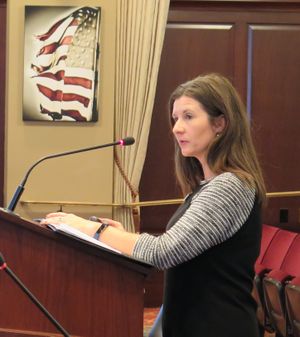Idaho Commerce chief optimistic on business growth
Megan Ronk, director of the Idaho Department of Commerce, told lawmakers today, “Overall, I would say that I’m very optimistic. Certainly we have some challenges that we have to work through and that we’ll continue to face at a statewide level, but Idaho is continually recognized, especially these past couple of years, as a great place to do business.”
She said Idaho’s been strong in employment, with job numbers increasing by 3.6 percent from March of 2015 to March of 2016, the highest percentage in the nation. “Real GDP was up 2.8 percent in the second quarter of 2016, the third-largest nationally,” she said. “Wage growth continues to be strong – 4.2 percent in the second quarter of 2016, twice the national average and fourth overall nationally.”
Ronk said the department is expecting to continue to see job and business growth in the manufacturing sector related to paper, chemicals, fabricated metal products, machinery and electrical equipment, data processing and other information services including cloud-based services, and health care. “Agriculture will continue to be strong and fuel growth in our food processing sector as well,” she said.
Idaho exports have been dropping, as have U.S. exports overall, in part because of the strength of the dollar. Ronk said the state is hoping for a “bounceback over a rather challenging 2015” for exports.
Tourism, she said, “continues to be a bright spot in Idaho’s economy.” State lodging tax collections have been rising steadily since 2010; travel and tourism are Idaho’s third-largest industry behind agriculture and technology, Ronk said. “We anticipate that lodging collections will continue to be strong in the coming year; we’re forecasting about a 9 percent annual growth, which will be supported with the addition of over 1,800 new properties and rooms available throughout the state.”
Ronk also highlighted the Tax Reimbursement Incentive program, which provides a refundable tax credit to companies that create specified numbers of new jobs that pay above the average wage in the county. Thirty-three companies have been awarded the incentive in the two and a half years the program has been in place, she said. Among those, about 5,200 new jobs are projected to be created, she said, along with more than $960 million in planned capital investment. “We anticipate about $2.3 billion dollars in new wages coming into the state,” she said.
She estimated that the state will receive $257 million in new direct revenue as a result of the incentives issued thus far, while granting credits totaling $60 million. “So based on our analysis, we’re looking at about a 4-1 return on investment, which I think is something we’re pretty proud of.”
Among the 33 projects, she said, 18 have been in rural areas and 15 in urban areas; 16 involved existing Idaho businesses that were expanding, while 17 were new businesses coming to the state.
Ronk said the department has established a new retention team to reach out to existing Idaho businesses. “You’re going to see us continuing to pay more and more attention to our existing Idaho companies,” she said, “to find out what we can do to continue to support their growth and creating new jobs in Idaho.”
She concluded, “We have much to be proud of, and people are taking notice.”

